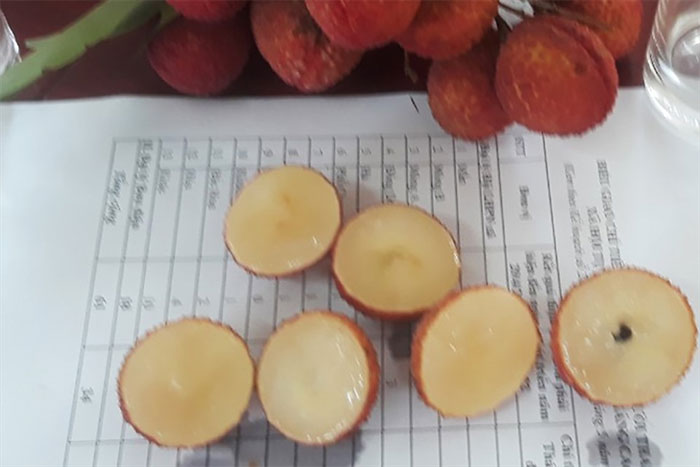After 2 years of experimentation, this year, some seedless lychee trees have successfully borne fruit, producing large, beautifully colored fruits with thick flesh and a distinctly sweet and crunchy taste.
On June 30, Mr. Le Ba Thanh – Deputy Director of the Department of Agriculture and Rural Development of Bac Giang Province – announced that the province has successfully trialed seedless lychee.
According to Mr. Thanh, this year, some seedless lychee trees have flowered and set fruit.

Seedless lychee grown in Luc Ngan.
“The lychee produces large fruits, has beautiful colors, thick flesh, and a very characteristic sweet and crunchy taste. Notably, the seedless fruit, when planted in isolation, has only a few very small underdeveloped seeds due to cross-pollination,” Mr. Thanh stated.
Local residents are currently taking grafting eyes to improve this seedless lychee variety. Initially, the seedless lychee has shown promising results, growing and developing similarly to the local lychee varieties.
“The Department will continue to collaborate on research and expand this lychee variety in the province to contribute to product diversification and increase income for lychee farmers,” emphasized the Deputy Director of the Department of Agriculture and Rural Development of Bac Giang Province.
Previously, at the end of 2019, the Department of Agriculture and Rural Development of Bac Giang Province collaborated with relevant units and local residents to introduce the seedless lychee variety for planting in Tan Son Commune (Luc Ngan District) with over 500 trees.
This year, the lychee production in Bac Giang is estimated to reach 180,000 tons, including early lychee covering about 6,750 hectares with an output of approximately 60,000 tons; and main season lychee covering about 21,250 hectares with an output of around 120,000 tons. Lychee produced according to VietGAP and GlobalGAP standards continues to expand, accounting for over 80% of the output to meet domestic consumption and export demands.
In addition to the domestic market, the province is focusing on export markets.
For the Chinese market, the province is concentrating on production management for 149 planting area codes, covering an area of 15,867 hectares with an output of approximately 95,000 tons.
For the Japanese market and other markets, the total number of planting area codes this year has risen to 35 codes, covering an area of 269.45 hectares with an output of about 2,000 tons.
For the markets in the United States, Australia, and the EU, production is maintained under 18 planting area codes covering an area of 218 hectares; the output is estimated to be around 1,600 tons.


















































